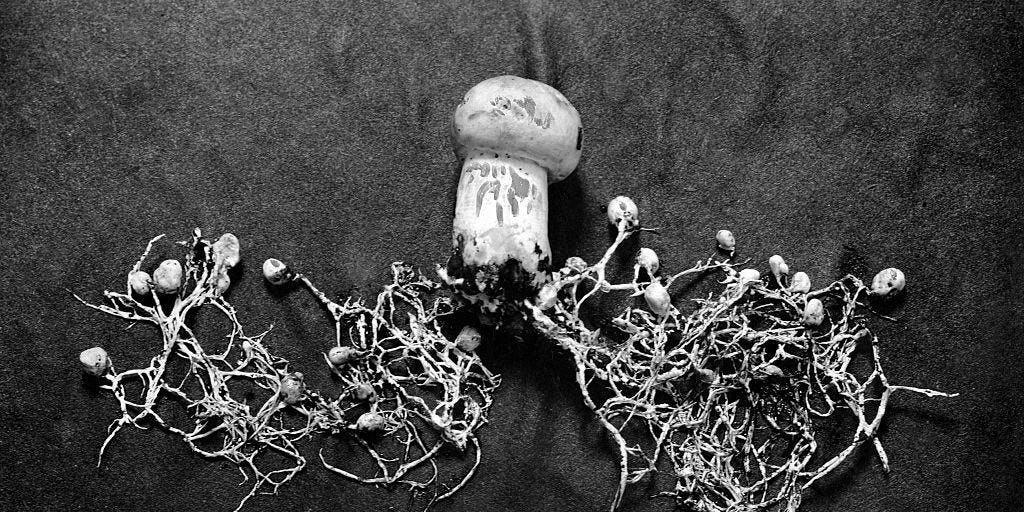- A new study claims that mushrooms have great intelligence to the point that they can make decisions.
- A group of scientists tested how fungi would grow across block patterns and found that they grew in strategic, resource-conserving ways that demonstrate the ability to communicate throughout the mycelial network.
- These findings could not only lead to a better understanding of these relatively mysterious organisms, but also to a better understanding of intelligence itself.
Who we are, what we do, how we think and why we think are all wrapped up in the inner workings of our brains. Still the source of some of the greatest mysteries we as humans are investigating, the brain is a truly remarkable organ that is only now beginning to understand itself and the intelligence it facilitates.
As we continue to probe the depths of our brains, we are increasingly realizing that intelligence is not a one-size-fits-all situation. Octopuses, for example, are highly intelligent animals that do not have a brain that resembles ours. Instead, they have what’s called “distributed intelligence,” which allows each of their arms to literally think for themselves.
But it gets (perhaps) even weirder – especially when you leave the animal kingdom behind altogether. According to a new study, published in the journal Fungal ecologyfungi may have their own unique measure of intelligence, making them capable of recognizing basic shapes and making decisions along the networks they build.
“You’d be surprised how much mushrooms are capable of,” said Yu Fukasawa, lead author of the study, in a press release. “They have memories, they learn and they can make decisions. Honestly, the differences in how they solve problems compared to humans is staggering.”
When biologists talk about fungi, they don’t just mean fungi. Fungi are the parts of most fungi that you can see, but they are far from the bulk of the organism. Most fungi reside underground in the form of a root-like system known as mycelium. Mycelial networks, made up of thin, thread-like threads called hyphae, can be extremely extensive—in fact, the largest organism on Earth is a fungus known colloquially as the Humongous Mushroom. Residing in Oregon’s Malheur National Forest, its mycelial network covers nearly four square miles.
In addition to being large, mycelial networks are known to be able to communicate information along their networks, just as neurons in the human brain do. And it is this ability that the scientists behind this new paper wanted to put to the test. So they carved out some wood block food sources for their fungi (wood eaters Phanerochaete velutina) in two different arrangements—a circle and a cross—to see how their micelles would form. Each block was pre-colonized with the fungus and could provide a jumping off point for mycelial development.
Theoretically, if these mushrooms were to grow like a plant, they would simply grow in a circle around each of the blocks, not at all affected by the positions of the other blocks in the experiment. They would just keep arriving from a central point.
But it didn’t happen like that. Instead, the mycelium chose efficiency. According to the press release:
“For cross-regulation, the degree of connectivity was greatest in the four outermost blocks. It was hypothesized that this occurred because the outermost blocks could serve as ‘outposts’ for the mycelial network to launch foraging expeditions, therefore requiring denser connections. In the circle arrangement, the degree of connectivity was the same in any given block. However, the dead center of the circle remained clear. It was proposed that the mycelial network did not see a benefit in over-extending itself in an already well-populated area.”
From this data, the researchers concluded that the mycelial network was able to communicate with other parts of the self much like a neural network in the brain, communicating what it was experiencing to the rest of the self and making decisions based on that information. . It was growing strategically so that resources are not wasted, and communicating with other parts of the network exactly how to do just that.
The authors of this paper hope that their findings will provide a jumping off point for us to move towards a better understanding of these extraordinary organisms and a better understanding of intelligence in general. Especially in the age of AI, there is an ever-increasing desire to deeply understand how real intelligence works. But there’s also just the drive to truly understand ourselves—perhaps a humble mushroom will one day hold the key to understanding the workings of our minds.
Jackie is a writer and editor from Pennsylvania. She especially enjoys writing about space and physics, and enjoys sharing the strange wonders of the universe with anyone who will listen. She is watched over in her home office by her two cats.

